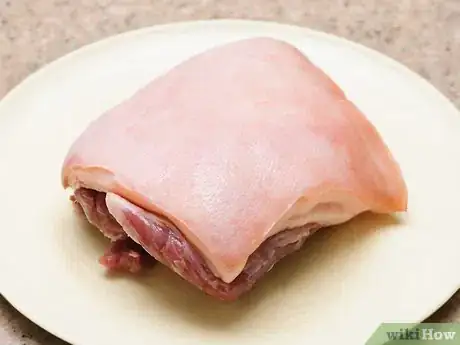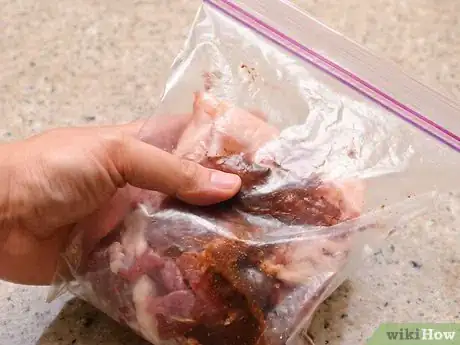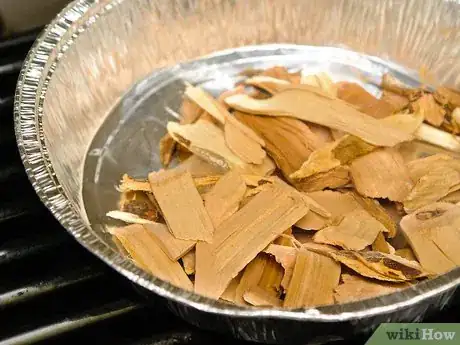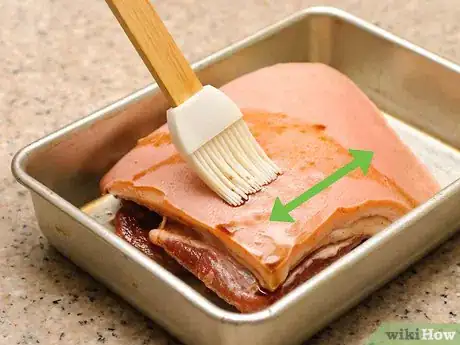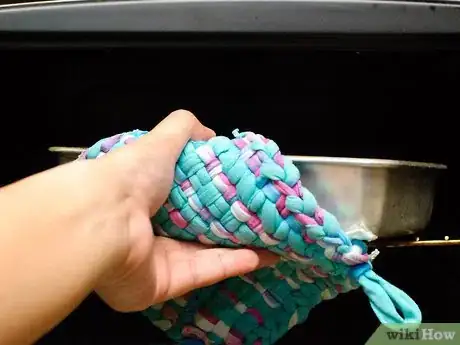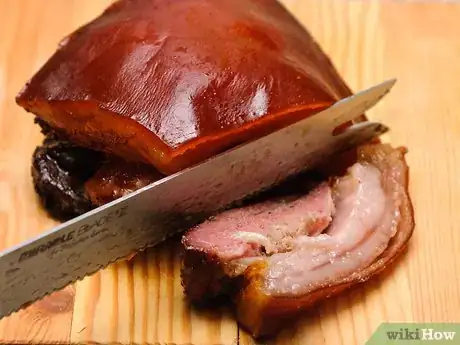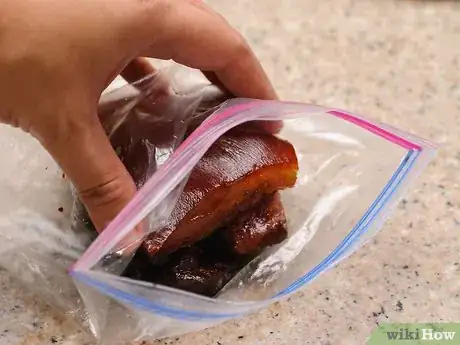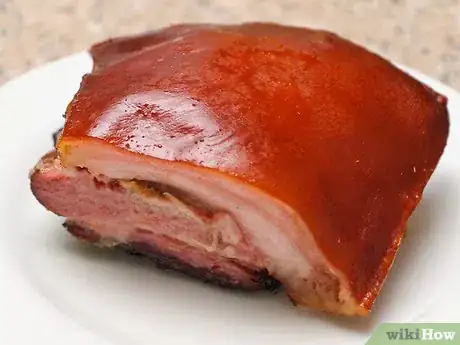This article was co-authored by wikiHow Staff. Our trained team of editors and researchers validate articles for accuracy and comprehensiveness. wikiHow's Content Management Team carefully monitors the work from our editorial staff to ensure that each article is backed by trusted research and meets our high quality standards.
This article has been viewed 36,992 times.
Learn more...
Bacon is a cured pork product made from pork belly. The curing process requires a large quantity of salt, usually mixed with other ingredients to help infuse flavor. After curing the pork belly, people usually smoke bacon to help give it its signature, robust flavor. The process for curing and smoking bacon is similar regardless of the ingredients you add during curing or your smoking method. After practicing with a standard recipe, you can easily get creative with your own curing flavors and ingredients!
Ingredients
- 5 pounds of pork belly with the skin on
- 1/4 cup kosher salt
- 2 teaspoons pink curing salt
- 1/4 packed dark brown sugar
- 1/4 cup honey (preferably chestnut honey)
- 2 tablespoons red pepper flakes
- 2 tablespoon smoked sweet paprika
- 1 teaspoon cumin seeds
- Liquid smoke (if no smoker)
Steps
Curing the Bacon
-
1Purchase the pork belly. Procuring the pork belly can be the hardest part of the entire homemade-bacon process since most grocery stores don’t carry it. Try a local butcher or a restaurant supplier in your area to find the pork belly.
- Local butchers tend to have better quality pork bellies available than a restaurant supplier. Also, a restaurant supplier may only sell in bulk quantities much larger than what you need.
-
2Rinse the pork belly thoroughly. Once you get the pork belly home from the butcher, rinse it thoroughly to remove any blood or anything else on the meant. Pat the pork belly dry and then transfer it to a resealable two-gallon plastic bag.[1]
- After you’ve cleaned and patted the pork belly dry, the surface will feel slightly tacky.
- You may also want to trim any thin edges off the pork belly if it has any. You want to place roughly a long rectangular piece into the plastic bag.
Advertisement -
3Make the spice rub. To make the spice rub, mix the kosher salt, pink salt, brown sugar, honey, red pepper flakes, paprika, and cumin in a bowl.[2] Mix until everything is spread evenly throughout the honey. This recipe is just one of a near endless variety you can use to create unique flavor profiles for your bacon. Other spice rub examples include:
- 2.5-3 pounds skinless pork belly, 1/4 cup kosher salt, 2 teaspoons pink curing salt, 1/2 cup sugar, 1 teaspoon maple syrup, 1 tablespoon (14.8 ml) Bourbon, 1 teaspoon freshly ground black pepper, and hickory smoke during the smoking process (whether actual hickory wood in your smoker or hickory liquid smoke roasted in your oven).
- 2 1/2 pounds skin-on pork belly, 2 1⁄2 tablespoons (37.0 ml) kosher salt, 1 1/2 tablespoons sugar, a tablespoon black peppercorns, 1 teaspoon fennel seed, 1 teaspoon caraway seed, 1 teaspoon dried rosemary, 1 teaspoon dried thyme, 2 bay leaves, 1 clove garlic, finely chopped.[3]
- 1 pound of pork belly, 1 1/2 teaspoons Morton's kosher salt, 1/2 teaspoon pink curing salt, 2 tablespoons (29.6 ml) hoisin sauce, 2 tablespoons honey, 1 tablespoon (14.8 ml) soy sauce, 1 tablespoon powdered ginger, 1 teaspoon powdered garlic, 1 teaspoon Sriracha or other hot sauce, 1/4 teaspoon 5 spice powder, and 2 tablespoons (29.6 ml) water.[4]
-
4Coat the pork belly. You’ll have enough of the spice rub to evenly coat the until piece of pork belly.[5] Roll the mix around with the pork belly in the plastic bag until everything is coated.
-
5Refrigerate the pork for 7-10 days. Seal the plastic bag and place it in the refrigerator. You’ll flip the bag once a day to keep the even coating, and the process will take approximately 7-10 days.[6]
- The duration ultimately depends on the thickness of the pork belly. A thin belly (around 1.5 inches thick) will take seven days while a thicker belly (2-3 inches) will take the entire ten days.[7]
- You can test how cured the pork belly is by touching it when you think it’s close to ready. The cured meat will be firm to the touch all over like a cooked steak. If it still feels spongy and soft, then it needs more time.
-
6Rinse thoroughly. Once the meat has cured, you can remove it from the bag and rinse it thoroughly. Discard any solids from the rub on the meat as well. Pat the meat dry once you have rinsed it well.
-
7Refrigerate for forty-eight hours. After thoroughly rinsing the meat, you will need to refrigerate it again. Refrigerate it uncovered for a full forty-eight hours.[8]
Smoking the Bacon with a Smoker
-
1Get a smoker. This part requires you to have access to a smoker. Most people agree that a smoker yields the best results for bacon. However, if you cannot get access to a smoker, skip down to Part 3 for steps on how to use an oven instead.
-
2Use applewood in your smoker. Applewood is one of the most common to use while smoking bacon because it’s light character isn’t too rich against the already rich cured pork. Follow any specific manufacturer’s instructions for using applewood in your smoker, and set the smoker to 200 °F (93.3 °C).[9]
- Hickory and maple are also popular options when smoking cured pork belly. However, the light character of applewood works best for those just getting started with making homemade bacon.
- If you’re also new to using a smoker, you can find more information at: How to Use a Charcoal Smoker and How to Use an Electric Smoker.
-
3Smoke the pork belly for three hours. Because of its light flavor, apple smoke takes several hours to permeate the meat. You should smoke the pork belly for around three hours.[10]
- For thicker pieces (2-3 inches thick), you may need more time. Use a meat thermometer and ensure that the internal temperature of the pork belly reaches 150°F.
-
4Slice and cook as desired. Some people choose to remove the rind created by the curing process. However, it’s completely optional.[11] From there, you can slice and prepare the bacon to suit your favorite recipes.
-
5Store the bacon. Wrap any of the bacon that you don’t use immediately in plastic. You can refrigerate the bacon for up to a week, or you can also freeze it for up to two months if you plan on saving it.[12]
Using an Oven as an Alternative to a Smoker
-
1Set your oven to 200 °F (93.3 °C). Though many believe using a smoker yields the best results, you can also use your oven at home as an alternative to a smoker. Start by setting your oven to 200°F.
-
2Brush the pork with liquid smoke. As the oven preheats, gently brush the entirety of both sides of the pork belly with liquid smoke.
-
3Roast the pork belly for 2-2.5 hours. You want to place it with the fat side up on a rack over a roasting pan, and then roast the pork belly for 2-2.5 hours.
- You can find liquid smoke online or even some varieties at your local grocery store.
- As with a smoker, check the pork belly with a meat thermometer to ensure that it reaches an internal temperature of 150°F.
-
4Slice and cook as desired. Some people choose to remove the rind created by the curing process. However, it’s completely optional.[13] From there, you can slice and prepare the bacon to suit your favorite recipes.
-
5Store the bacon. Wrap any of the bacon that you don’t use immediately in plastic. You can refrigerate the bacon for up to a week, or you can also freeze it for up to two months if you plan on saving it.[14]
-
6Finished.
References
- ↑ http://www.foodnetwork.com/recipes/homemade-bacon.html
- ↑ http://www.foodnetwork.com/recipes/homemade-bacon.html
- ↑ http://www.saveur.com/article/Recipes/Home-Cured-Bacon
- ↑ http://amazingribs.com/recipes/porknography/making_bacon_from_scratch.html
- ↑ http://www.foodnetwork.com/recipes/homemade-bacon.html
- ↑ http://www.foodnetwork.com/recipes/homemade-bacon.html
- ↑ http://www.foodnetwork.com/recipes/homemade-bacon.html
- ↑ http://www.foodnetwork.com/recipes/homemade-bacon.html
- ↑ http://www.foodnetwork.com/recipes/homemade-bacon.html
- ↑ http://www.foodnetwork.com/recipes/homemade-bacon.html
- ↑ http://www.foodnetwork.com/recipes/homemade-bacon.html
- ↑ http://www.foodnetwork.com/recipes/homemade-bacon.html
- ↑ http://www.foodnetwork.com/recipes/homemade-bacon.html
- ↑ http://www.foodnetwork.com/recipes/homemade-bacon.html
- ↑ http://www.foodnetwork.com/recipes/homemade-bacon.html
